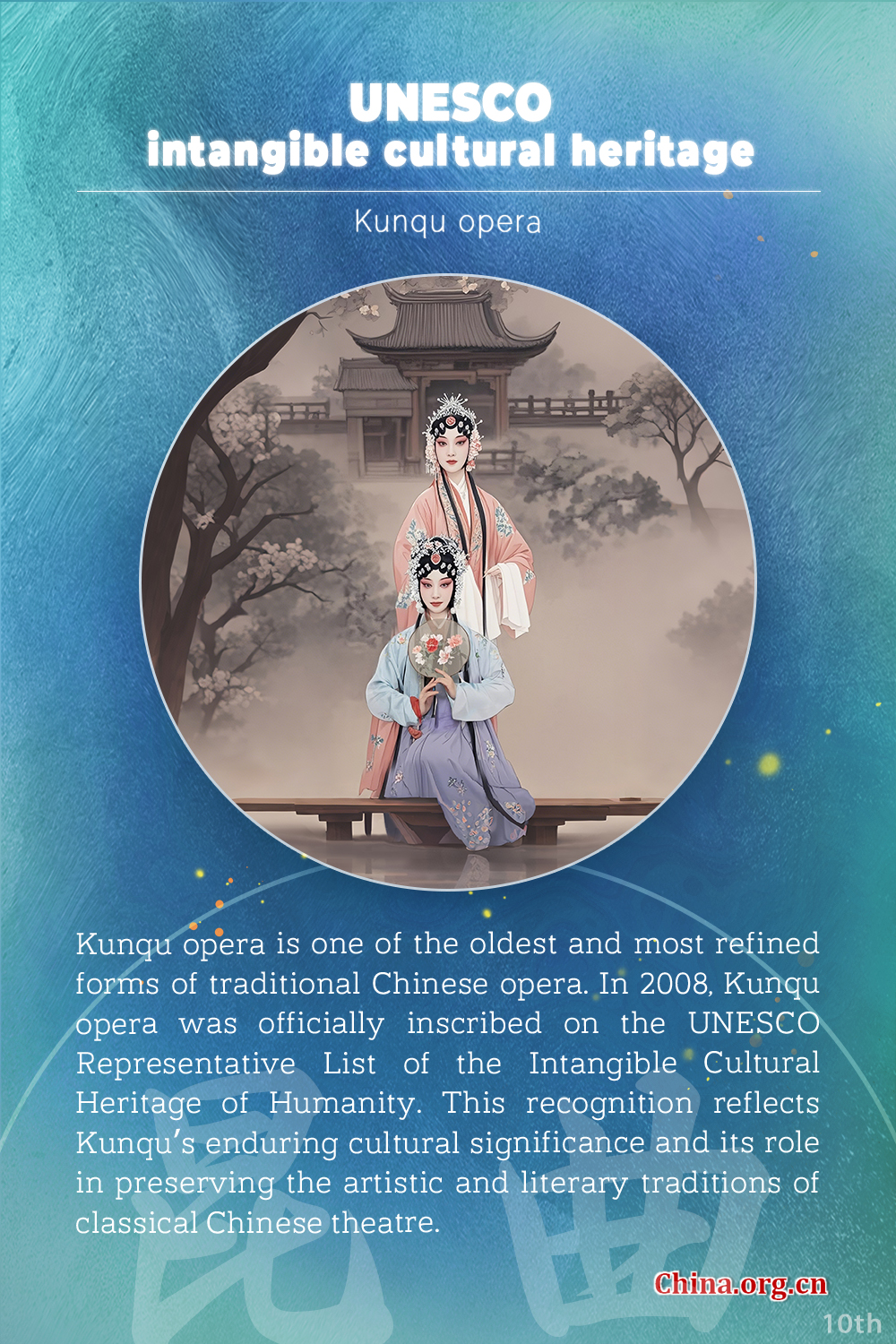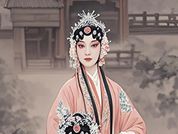
 0 Comment(s)
0 Comment(s) Print
Print E-mail China.cn, April 20, 2025
E-mail China.cn, April 20, 2025Editor's note: Kunqu opera is one of the oldest and most refined forms of traditional Chinese opera. Renowned for its graceful movements, poetic lyrics and elegant melodies, Kunqu has had a profound influence on many regional opera styles in China, including the more widely known Peking opera.

In 2008, Kunqu opera was officially inscribed on the UNESCO Representative List of the Intangible Cultural Heritage of Humanity. This recognition reflects Kunqu's enduring cultural significance and its role in preserving the artistic and literary traditions of classical Chinese theatre.
Kunqu opera originated in Kunshan, Jiangsu province during the Ming dynasty in the 14th century. It reached its artistic peak between the 16th to 18th centuries under the Ming and Qing dynasties, when it flourished in imperial courts and among the educated elite. The opera is closely associated with the poetic language of classical Chinese literature and features elaborate choreography, refined singing techniques and highly stylized acting.
The name "Kunqu" refers to the style of music and vocal performance developed from the Kunshan tune. This distinctive music, combined with intricate hand gestures, symbolic movements and richly embroidered costumes, gives Kunqu its elegant and expressive aesthetic.
Kunqu opera is particularly notable for its close relationship with Chinese classical literature. Many of its scripts are based on famous literary works, such as "The Peony Pavilion" by Tang Xianzu and "The Palace of Eternal Life" by Hong Sheng. These operas often explore themes of love, loyalty, moral conflict and the tension between personal desire and social role.
Despite its historical prominence, Kunqu opera faced serious decline in the 20th century. However, significant revival efforts have taken place in recent decades. Following UNESCO's recognition, the Chinese government and cultural institutions began to invest in the protection and revitalization of Kunqu. Key performance troupes, such as the Suzhou Kunqu Opera Theatre and the Northern Kunqu Opera Theatre, have played important roles in training young actors, restoring classical repertoires and promoting the art form both domestically and internationally.
Kunqu is now taught at several arts academies, and contemporary performances often incorporate modern stagecraft to appeal to younger audiences. In addition to traditional performances, abbreviated versions of Kunqu scenes are regularly featured in educational programs and cultural festivals. While the number of Kunqu performers remains limited compared to more commercial opera forms, its influence as a cultural treasure has been growing steadily.
UNESCO recognized Kunqu opera as a masterpiece for its exceptional aesthetic achievement and its embodiment of classical Chinese values. The organization praised Kunqu's literary richness, subtle performance techniques and its contribution to the continuity of traditional Chinese opera. Kunqu was also acknowledged for its comprehensive integration of music, dance, poetry and drama — making it a living archive of Chinese cultural heritage.
In its recognition comments, UNESCO emphasized the importance of preserving the art form through education, performance and community involvement. The designation aimed to encourage not only preservation efforts by the Chinese government and opera institutions but also public awareness and appreciation of this delicate and profound cultural expression. Through international recognition and local commitment, Kunqu continues to inspire new generations and remain a vibrant part of China's intangible heritage.
Discover more treasures from China on UNESCO's ICH list:
? 2024: Spring Festival
? 2022: Traditional tea processing
? 2020: Wangchuan ceremony, taijiquan
? 2018: Lum medicinal bathing of Sowa Rigpa
? 2016: Twenty-four solar terms
? 2013: Abacus-based Zhusuan
? 2012: Training plan for Fujian puppetry performers
? 2011: Shadow puppetry, Yimakan storytelling
? 2010: Peking opera, acupuncture and moxibustion, wooden movable-type printing, watertight-bulkhead technology of Chinese junks, Meshrep
? 2009: Yueju opera, Xi'an wind and percussion ensemble, traditional handicrafts of making Xuan paper, traditional firing techniques of Longquan celadon, Tibetan opera, sericulture and silk craftsmanship, Regong arts, Nanyin, Khoomei, Mazu belief and customs, Dragon Boat Festival, Manas, Craftsmanship of Nanjing Yunjin brocade, Xinjiang Uygur Muqam art, Hua'er, China engraved block printing technique, Chinese traditional architectural craftsmanship for timber-framed structures, Chinese paper-cut, Chinese calligraphy
